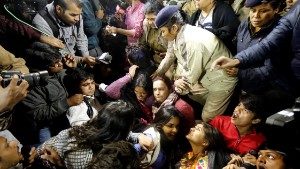New Delhi – There’s crime and then there’s evil, pure and simple.
By any standards, the events of December 12, 2012 can only be described as evil — the very worst depravity our race is capable of.
Six men repeatedly raped a woman; they treated her like a crazed dog would ravage a toy doll, beating, poking, piercing. The injuries were so severe the victim’s internal organs were damaged beyond repair. Then they threw her away to die.
Police say one of the rapists hanged himself in prison. Four others got the death sentence. There was one more rapist, a young man just months short of his 18th birthday. He didn’t know it then but that small quirk of timing would end up saving his life. He’s now a free man, let off by the legal system.
Why?
Indian juvenile law states the maximum sentence for any juvenile can be no more than three years — no matter the severity of the crime. No matter the fact that he is now nearly 21 and by a number of accounts in the media has shown little remorse for his actions.
For many Indians the release of the juvenile rapist re-opens three-year-old wounds. The letter of the law was followed but it doesn’t feel like justice was delivered.
The case also re-opens the painful questions: Is India doing enough to protect women? Is it creating a strong enough deterrent for crimes against women? What’s changed since that awful day in 2012?
What’s changed?
According to Kirti Singh, a human rights activist and lawyer, “the entire body of laws around sexual assault has changed” in the country’s Supreme Court, making India’s laws tougher than those of most other countries.
India’s 2013 Criminal Law Amendment Act broadens the definition of rape to include any form of penetration; it lists out strict punishments not only for rape but also for sexual assault, voyeurism, and stalking.
“The process began before 2012,” said Singh. “But the 2012 gang-rape case hastened the legal changes.”
Singh also pointed out how fast-track courts can now hear rape cases — but there aren’t enough of them across the country.
Perhaps the greatest fallout from the 2012 rape is how India has begun talking about rape: on TV, in the papers, in public. It no longer feels like rape is a taboo issue. Quite the opposite, in fact: following the news in India invariably means hearing about gruesome stories of sexual assault from far flung corners of the country.
According to India’s National Crime Records Bureau 36,735 rapes were recorded in 2014-up some three-fold since 2012. 28% of the reported cases turned into convictions.
The rise in the number of reported rapes is sometimes interpreted as there being more rapes taking place. The truth is we don’t know. Unlike other crimes like stabbings or shootings, rapes rarely get reported. It’s more likely that the sharp increase in reported cases comes from a national awareness about the crime, the importance of reporting it, and a sense that the law can punish offenders.
There are other, smaller steps authorities have been pushing. Delhi’s police have installed GPS trackers on public buses and auto rickshaws, in the hope of deterring would-be rapists. And as more Indian women get access to smartphones, they’ll be able to let their family and friends track their whereabouts any time they feel unsafe.
Deep-rooted problems
Singh pointed out that India’s problems with rape can’t simply be fixed by tighter laws.

“As a society we have had a fire-fighting response,” she said. “Calls for revenge and retributive justice can ensure would-be criminals don’t have a sense of impunity but it doesn’t fix all of our problems.”
India is ill-equipped to process not just sexual assaults and rape, but all kinds of crime, says Singh who noted that India has a shortage of forensic laboratories. To add to that India has one of the worst police-to-citizens ratios in the world and far fewer lawyers and judges than it needs to process cases.
That’s just infrastructure.
There’s an even deeper set of problems for India to come to grips with: how women are treated in general.
According to the World Economic Forum’s 2015 Gender Gap report, India ranks 108th in the world for the opportunities it gives women. India’s women rank 136th in the world for labor force participation; 127th in the world for their literacy rate; 115th in the world for representation in parliament.
It all starts at the very beginning.
India ranks 143rd of 145 countries for its female-to-male sex ratio. What this means is that Indians continue to prioritize male children, often aborting female ones repeatedly.
Indian society tends to have some of the worst excesses of patriarchy. Marriage dowries continue to be demanded and received. Boys grow up basking in the knowledge that they are special. Given all these discrepancies, is it really a surprise that India has a bad reputation for the way it treats women? And is it really a surprise that women don’t feel safe?
As reported by CNN
